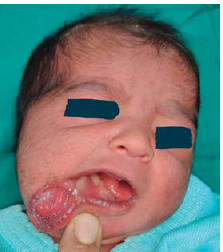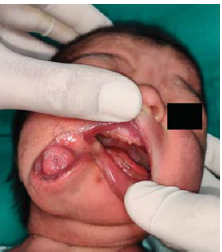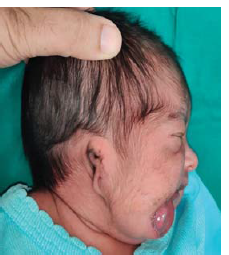Translate this page into:
One face, two oral cavities
[To cite: Karmakar S, Ramani S, Mishra B. One face, two oral cavities. Natl Med J India 2024;37:292. DOI: 10.25259/NMJI_753_2023]
A 1-week-old boy presented with two oral cavities. The baby was the first child born of a non-consanguinous marriage, at full term without any complications. On examination, a normal oral cavity was situated in the midline. Another oral cavity was seen situated to the right and slightly lower than the median oral cavity (Fig. 1). The duplicated oral cavity also had a duplicated tongue, oral mucosa and vermillion with minimal salivary secretion (Fig. 2). The duplicated tongue was not mobile and the lips were incompetent. The duplicated oral cavity did not lead to the oropharynx. The baby was also found to have a small and deformed right ear (Fig. 3). The trunk and limbs were normal.

- Frontal view, showing two oral cavities

- Basal view

- Right lateral view, showing microtia
Diprosopus includes the spectrum, ranging from partial duplication of isolated facial structures to the complete doubling of all facial structures.1,2 It can be associated with other anomalies such as macrostomia, duplication of tongue, orbital hypertelorism and cleft palate, or as part of syndromes such as Pierre–Robin and Kleppel–Feil syndrome.2 Our patient had a rare presentation, with isolated partial craniofacial duplication and right-sided microtia. About 100 cases of diprosopus have been published in the literature, with only 7 of partial duplication among them.3
Theories of embryological mechanisms suggested are forking of the notochord, duplication of the mandibular growth centre, duplication of the first branchial arch, partial doubling of the prosencephalon or olfactory placodes, and duplication of the growth centres around the stomodeal plate.1,2 This disorder is not genetic in nature but a malformation, as evident by the affliction of one of the two monozygotic twins.2
Conflicts of interest
None declared
References
- Duplication of the oral cavity and mandible: A rare congenital craniofacial anomaly. BMJ Case Rep. 2020;13:e233799.
- [CrossRef] [PubMed] [Google Scholar]
- Partial duplication of the face: Case report and review. Plast Reconstr Surg. 1991;87:759-62.
- [CrossRef] [PubMed] [Google Scholar]
- Diprosopus: A unique case and review of the literature. Teratology. 2002;66:282-7.
- [CrossRef] [PubMed] [Google Scholar]




